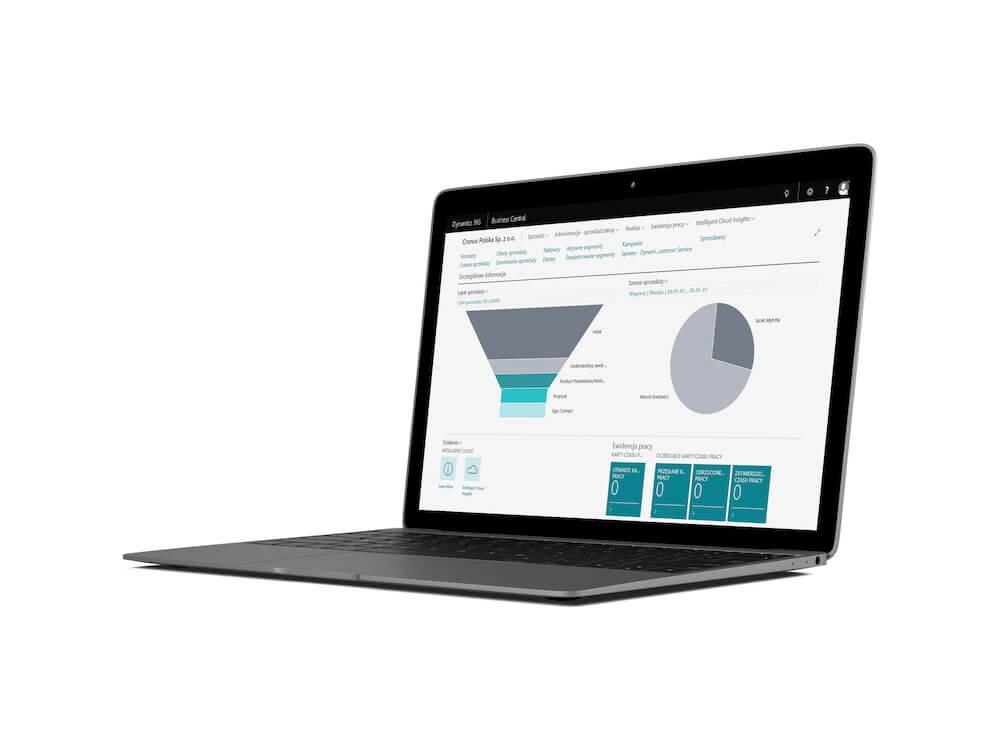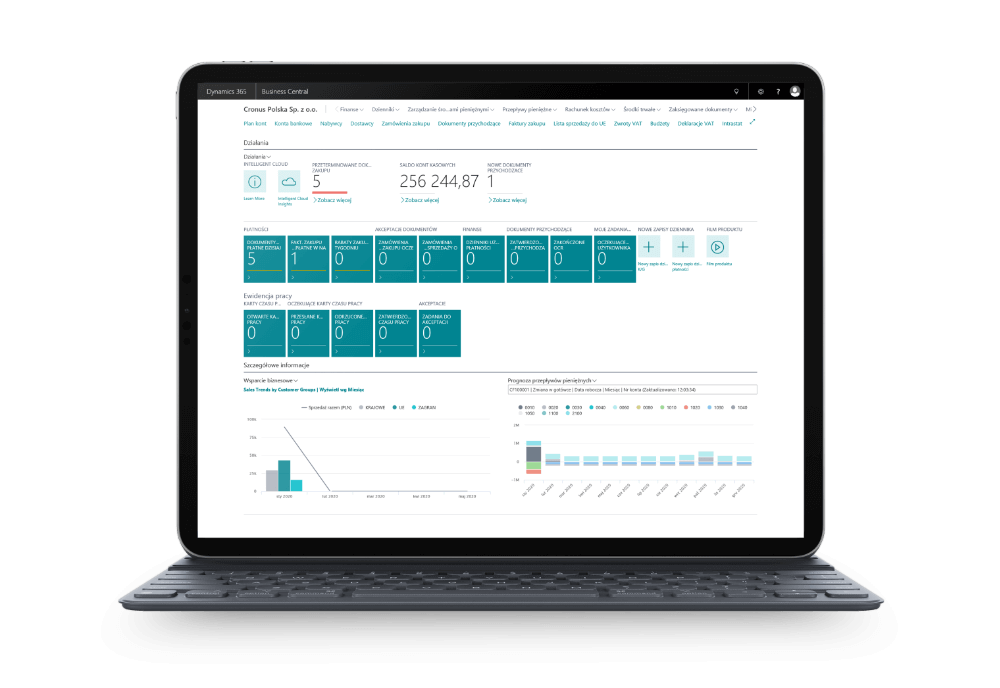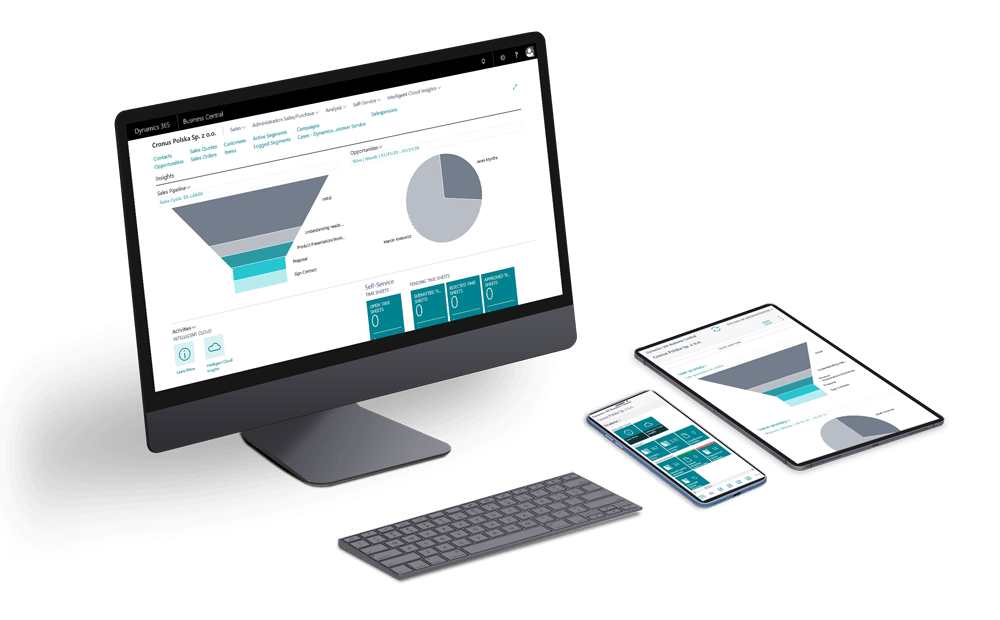
Microsoft Dynamics 365 Business Central
The Evolution to Digital Transformation
As an end-to-end ERP system, Microsoft Dynamics 365 Business Central (former Microsoft Dynamics NAV) improves performance in all business areas, from finance through purchases and sales, customer relationship, to service and manufacturing. Ensuring intuitive user experience, it is not only easy to use but also fast to implement.
Dynamics 365 Business Central is an innovative business platform that offers exceptional capabilities such as scaling and extending the functionality with new modules and applications to accommodate the specific needs of companies operating in various industries. Such enhancements can be built without any intervention in the source code.
Using a wide range of ready-to use extensions and applications available on Microsoft AppSource, you can also customize the functionality to serve specific business needs.
In Dynamics 365 Business Central, you work with a familiar and intuitive interface that offers built-in business intelligence and workflow management tools, and integration capabilities. All data is standardized and stored in a single data base, which improves data consistency and system operability.

Rich functionality available in the standard version
Microsoft Dynamics 365 Business Central is a comprehensive business solution with unprecedented capabilities for process integration. Right from the start, you can experience all the benefits of implementing the system. By using more efficient tools, your financial management, sales, service or manufacturing processes become easier.
The system is offered in two licensing options – Essentials or Premium.
Dynamics 365 Business Central Essentials includes the functionalities from the following areas:
Dynamics 365 Business Central Essentials includes the functionalities from the following areas:
- Financial Management
- Sales
- Purchases
- Warehouse Management
- CRM
- Human Resources Management
- Projects
Dynamics 365 Business Central Premium includes the functionalities from the following areas:
- Business Central Essentials
- Service
- Manufacturing
| Financial Management | Customer Relationship Management | Supply Chain Management | Project Management | Human Resources Management | Service Management | Manufacturing |
|---|---|---|---|---|---|---|
| Chart of Accounts | Contacts | Sales and Purchase Orders | Resources | Employee registration | Service Items | Production Orders |
| Dimensions | Segmentation | Inventory Availability | Resource Capacity and Availability | Service Contract Management | Zlecenia serwisowe | Version Management |
| Process Payments | Sales Opportunities | Sales and Inventory Forecasting | Jobs | Qualifications and Confidential Information | Service Orders | Agile Manufacturing |
| Cash Flow Forecast | Campaigns | Nonstock Items | Time Sheets | Absence Log | Planning & Dispatching | Supply Planning |
| Budgets | Interactions | Item Substitutions | Employee Expense Management | Service Contract Management | Demand Forecasting | |
| Deferrals | Dynamics 365 for Sales integration | Locations | Service Price Management | |||
| Fixed Assets | Inventory Movements | Warranty/font> | ||||
| Bank Account Management | Warehouse Management | |||||
| Audit Trails |
The functionality of Dynamics 365 Business Central Essentials
The functionality of Dynamics 365 Business Central Premium

E-book:
Microsoft Dynamics 365 Business Central
The Evolution to Digital Transformation
Financial Management
Dynamics 365 Business Central supports the management of typical finance processes and information such as posting financial transactions, preparing financial statements, managing bank accounts, inventory costs, manufacturing costs, and fixed assets.
Chart of Accounts
The chart of accounts lists all the accounts used to post transactions to the general ledger. It contains balance sheet accounts and income statement accounts. In addition to default setup, in the chart of amounts you can use advanced features for VAT or tax processing. The user can create custom general ledger accounts that can be used in sales and purchase documents, general journals to post transactions in the general ledger. It is also possible to define dimensions that are used to add values in entries in order to ensure more accurate reporting.
Dimensions
In Dynamics 365 Business Central, dimensions are used in advanced financial analyses. Once dimensions are set up, you can assign default dimensions to customers, items, vendors, G/L accounts, jobs, resources and many more. For each dimension defined, you can create multiple dimension values. For example, before a sales transaction is posted, you can assign a customer group dimension to a sales document. While posting expenses, a department can be assigned to enable the analysis and comparison of expenses on the basis of departments.
Process Payments
Dynamics 365 Business Central streamlines payment processing. Payments are managed on the page where they were entered. With just a few clicks, you can mark your invoices as paid, and then run automated account reconciliation. In addition, payments for vendors are settled in the payment journal that comprises advanced features such as vendor priority setup and payment due dates. Payment reconciliation is processed by running the suggest vendor payments batch. If necessary, you can also modify the payment journal lines and then make payments electronically or by check. In the payment journal, you can simultaneously process and reconcile bank statement transactions. You only need to import bank statement files and the system will automatically settle transactions, applying all the advanced rules you have set up.
Cash Flow Forecast
To obtain a better overview of cash availability, companies need a better cash flow forecasting. The cash flow forecast functionality in Dynamics 365 Business Central has been designed to calculate projected cash flows including many cash sources such as receivables, payments, sales and purchase orders. Using expense and revenue data, the system analyses the potential impact of planned loans or investment. With embedded Cortana Intelligence, the system generates cash flow forecasts using machine learning based on historical revenues and expenses.
Budgets
The budget features are available for general ledger accounts, costs, sales and purchases.
Deferrals
In the system, it is possible to define deferral templates to automate the deferral settlement process for revenues and expenses within a predefined schedule.
Fixed Assets
Keeping track of fixed assets transactions, such as acquisitions, depreciations, write-downs, appreciations and disposals, you gain a comprehensive and up-to date overview of your fixed assets.
Audit Trails
Dynamics 365 Business Central automatically assigns audit trails and transaction posting descriptions. Moreover, users can set up custom reason codes to create additional audit trails.
Bank Account Management
Dynamics 365 Business Central supports diverse business needs and across different currencies, enabling users to create and manage multiple bank account.
Customer Relationship Management
Contacts
In the area of customer relationship management, contacts are used as master data. Contacts comprise personal and company data that is a basis for marketing related activities. The functionality enables you to register quotes for contacts, synchronize contacts with customers and vendors, and manage duplicate contacts.
Segmentation
Segments are groups of contacts that are assigned according to specific criteria. Dynamics 365 Business Central supports contact segmentation, so you can create segments depending on types of information collected. Segmentation criteria can be saved and reused for different marketing campaigns.
Opportunity Management
In Dynamics 365 Business Central, the relational management functionality offers features sales opportunities tracking, classification of sales processes into different stages and mainlining information required to manage your sales opportunities. Sales quotes can be linked directly to opportunities. Managing your customer journey and sales pipeline are parts of the opportunity management process.
Campaigns
Campaigns involve a set of customer-oriented activities, from catalogs and special offers to organizing marketing events. You can organize campaigns based on segments that you define for contacts, and record contact responses to campaigns as interactions.
Interactions
In addition to contact maintenance, the relationship management functionality enables you to track interactions. Such interactions include phone calls, invites and emails, as well as documents like sales quotes, orders, reminders, invoices and many other documents used within Dynamics 365 Business Central.
Dynamics 365 for Sales integration
Dynamics 365 Business Central can be easily integrated with Dynamics 365 for Sales. In just a few steps, you can synchronize your data, including sales orders, units of measure, currencies and item availability.
Supply Chain Management
Sales and Purchase Order Management
The system offers functions for setting up a wide range of sales and purchase documents that best meet your business needs. In Dynamics 365 Business Central, you can set up and use sales/purchase orders, blanket sales/purchase orders, and sales/purchase order processes. The invoicing process is fast and easy as it does not require sales order registration. Moreover, selected customers or customer groups can be automatically assigned special prices and discounts if the criteria you have set up, such as minimum order quantity or order date, are met. In such a case, the program applies the best price and the highest discount for a customer. Prices and discounts can be also defined in a sales document for specific lines. In addition to the line discount feature, you can set up an invoice discount which means linking the discount percentage to the document amount.
In Dynamics 365 Business Central, the monitoring and control of the whole purchase process is managed by means of an automated workflow. The workflow process involves document entry, including registration of paper documents using the OCR functionality. Replenishment orders are created just from notifications about available inventory and availability forecasts. Prices and discounts are assigned depending on the terms agreed upon with vendors such as minimum quantity or order date. To enhance control over purchase costs and expenses, you can implement advanced workflow and approval structures.
Item Availability
Efficiency in the sales process depends on the capability to track item availability in multiple locations over time. Dynamics 365 Business Central generates notifications if there are stock shortages for sales orders when they are processed. Thanks to this, you can react instantly, e.g. by creating a replenishment order or offering a substitute item.
Sales and Inventory Forecasting
Machine learning in Dynamics 365 Business Central ensures accurate sales and inventory forecasts using predictive analytics based on historical data in a specific period and source. If the inventory level decreases to zero, a replenishment order can be created just in the forecast chart.
Nonstock Items
In Dynamics 365 Business Central, it is possible to define non-stock items. This feature enables you to offer items that have not been registered in the inventory to your customers. This requires entering information in just a few fields. Then the item can be included in the price list, although it is not available in stock.
If a nonstock item is added directly to a sales document, the program automatically creates a new item on the nonstock item card using the item card template. The nonstock item template contains all the fields that you typically define for an item.
Item Substitutions
Dynamics 365 Business Central allows you to create and offer substitute items for all items. To define a substitute item, you just need to link similar items. If the requested item is not available, you can view all substitute items and select one to fulfill the customer’s order.
Locations
The system enables you to manage inventories in multiple locations such as a production plant, distribution center, warehouse, showroom, retail outlet, or service car.
Inventory Movements
The inventory tracking functionality provides information on locations where an item was moved and its value in-transit and at subsequent locations in the transfer process.
Warehousing
Dynamics 365 Business Central facilitates warehouse receipt and warehouse shipment processes such including put-aways and transfers. Inventory picks are part of the assembly, manufacturing and shipment processes.
Inventory management is based on bins that are used to track inventory transfers including pick-ups and put-aways. With transfer information available on hand, it is easier to optimize inventory usage. The warehousing functionality also supports the assembly of items for sales orders and warehouse orders.
Project Management
Resources
A resource is a person or device. The resource functionality can be used to group resources and register resource prices and sales. Resources can be tracked individually or as resource groups. Resource management is often used in combination with the jobs functionality.
Resource Capacity and Availability
In Microsoft Dynamics 365 Business Central resources are managed on the basis of a capacity you define. By monitoring the usage of resources, you obtain a complete overview of both the capacity and availability of your resources.
Jobs
The jobs functionality is used to register resource and material usage on specific jobs. This data is used to generate invoices. However, for jobs, invoicing can be based both on a fixed-price jobs and time and-material usage. The functionality supports typical project management tasks such as job setup, resource planning, budget management and job progress monitoring. It also provides tools for managing long-term projects enabling you to record the manhours and machine hours used and keep track of the usage of inventory items. With the jobs functionality, you gain accurate information, not only about individual jobs, but also the allocation of employees, machinery, and other resources being used in all projects.
All the data you need to manage the job from an administration and financial point of view is stored on a job card. The actions the job involves are defined as tasks. For each task you can set up capacity and sales, taking into account the resources and inventory usages. By applying the cost and price of items or resources used for the job, the system calculates actual job budgets, which ensures you can monitor the profitability of a job.
When working on a job, you can post item usage as soon as the items are purchased, by assigning a job number and task number in the purchase line, purchase order and purchase invoice. For resources and stocks, the usage is recorded and posted in job journals. To invoice a job, you need to set up an invoicing period. Job statistics provide you with an overview of job costs, enabling you to stick to the budget. The job functionality supports many types of services and consultancy tasks.
Time Sheets
Time sheets are a simple and flexible tool integrated with the service, job and resources functionalities. They are used to register the time worked and for by approvers to approve time consumption. In time sheets, employees enter the time spent on specific projects. Time sheets are managed by a timesheet administrator who designates which employees are obliged to fill in time registration data. When setting up time sheets, the administrator uses job planning lines. The employee is only required to confirm if the time worked on a job or task is the same as the budgeted time. Once the employee enters or confirms the hours worked and sends it for approval, the time sheet administrator or project manager can post the time consumption for a relevant task.
All approved expenses and sales revenues are posted in the profit and loss account, whereas work in progress is included in the balance sheet. For this purpose, a valuation method has to be set up. The program provides several valuation options e.g. progress. From the job card you can easily track the work in process and the recognized costs and sales.
Service Management
The Service Management functionality is available for Premium license users. This functionality supports the whole service process, including service and product supply chains and the delivery of services such as repairs. With Service Management, it is possible to quickly respond to service requests, plan and schedule repair assignments, follow up on the status of repair assignments, track and invoice repair costs, handle warranties, set and use service contracts, optimize inventory levels for spare parts, and improve spare parts for costing.
Service Items
The core of the Service Management module is comprised of the service item management functions. As service items, you can define the equipment or the item that needs to be serviced or repaired. With service item management you can record and keep track of all your service items data including contract information, component management, BOM reference and warranty information.
Service Orders
Service orders are created for equipment or services and they are used to record any maintenance activities or submitted repairs. According to the terms in your service agreement service requests can be initiated by the customer or created automatically. Data in the service orders can be filled in by a call center employee or by your repair shop.
Planning & Dispatching
Services registered as service orders need to be planned. In Dynamics 365 Business Central, service planning involves the assigning and distribution of job tasks between employees. The service planning feature allows for optimal setup based on regional zones, personnel skills, and priorities. The solution is also used to manage information about service teams and technicians, and filter data according to such criteria as availability, skills and warehouse inventory.
Warranty
You can manage warranty details on the service items and spare parts and record details on service levels, response times and discount levels.
Service Contract Management
Service terms and conditions and all related activities might be contractually stipulated. In the contract management module, you can enter an agreement specifying the required service quality. In this module, for instance, you can maintain information on contract history, contract renewal and contract templates. You can also generate contract quotes. The system also registers all detailed information service quality, response times, and discount levels, and the service history of each contract, including used service items and parts and labor hours.
Service Price Management
With service price management you can set up, maintain and monitor service prices. Using this functionality, you can define price calculation structures with all parameters related to service delivery.
Manufacturing Management
The Dynamics 365 Business Central Premium user license includes the manufacturing management functionality.
Bill of Material (BOM), routing and production capacity
Bill of Materials is a list of components required to produce a final product or semi-finished product. The list contains a description of all the components, their quantity and units of measure. The routing determines a sequence of operations required to produce a finished product.
With capacity settings, you can define a template for a production environment. In Dynamics 365 Business Central, you can define three types of production capacities for the three production units: production department, work center and machine center.
Production Orders
Production orders are used to manage the processing of purchased raw materials into final product and keep track of all related data. Production orders include information about the types and quantities of products to be manufactured, components required, routing steps or operations required to process components into finished products, and the work and machine centers where routing operations are performed. Work and machine centers represent available capacity.
Production orders are processed until they are completed. The manufacturing process involves the following actions such as starting a production order, picking up components from the warehouse, use of raw materials, producing a product, registering consumption and the final product in the production journal (optionally), and storing finished products in a warehouse.
Demand Forecasting
The demand forecasting functionality enables you to anticipate any type of demand. The forecasts can be easily converted into production plans and reconciled against the actual sales. The changes in the forecast are also applied to the existing production plans.
Production Planning
The system offers three production planning options:
• Sales order planning – a simplified planning function for creating production orders directly from sales orders. It is recommended for companies manufacturing items for specific orders in the MTO (make-to order) process. In the MTO process, component planning is minimized.
• Order Planning – a more advanced functionality that enables you to respond to the demand in multiple demand sources by creating various types of shipments. The program calculates demand without any supply for subsequent orders. With the planning tools, the planner can effectively combine and adjust supply planning, taking into account all other critical factors.
• Planning Worksheet – it can be used to generate the production plan by calculating a complete plan for replenishing the inventory or net requirement, including all information about demand that is available in the system and supplies that cover this demand. The planning mechanism is used for the main production schedule (MPS).
Subcontracting Functionality
Presently, manufacturing companies more and more frequently subcontract some of their orders. Therefore, it is important that the software they use should offer the subcontracting functionality. Microsoft Dynamics 365 Business Central supports the process enabling the setup integration for work centers, production orders and purchase orders. This way, it provides effective tools for managing quantities and costs within a typical workflow.
Advanced Capacity
If you experience any shortages in resources, it is necessary to plan capacity. In Dynamics 365 Business Central, the process involves planning production and capacity calendars for work and machine centers and keeping track of all planned capacity absences.
Shop Loading
Shop loading can be estimated by comparing the requirement and the actual capacity of a machine center. In order to monitor and manage shop loading, the system optionally uses the two assumptions:
- Shop loading with unlimited capacity – the system plans production regardless of the shop loading;
- Shop loading with limited capacity – the system plans production orders for a defined capacity percentage.
Human Resources Management
The human resources application area allows you to keep detailed employment records, including work contracts, confidential information, qualifications and other agreements with employees. You can also use human resources to register employees’ absences, which allows you to analyze registered absences as necessary. Employee ledgers and the suggest employee payments functionality in the payments journal allow you to register and track your employees’ expenses.

Innovative and streamiled user experience
With its functional enhancements, friendly user interface (which you also use in Microsoft Office 365), personalization features and notifications, system users can work more efficiently and effectively on their daily tasks.
Microsoft Dynamics 365 Business Central lets you get up and running just after it is launched. In a blink of an eye, you can process all your quotes, sales and purchase orders, and invoices. Ensuring a streamlined cash flow and financial management, the system also offers you business intelligence reporting.
Implementing a new solution does not have to mean time-consuming training and the disruption of the workflow and key processes.
Accessible from any place, any device and platform
What makes Microsoft Dynamics 365 Business Central unique among other business solutions available on the market is that the same range of functionalities is available for mobile and desktop devices.
It is common that mobile software versions offer diminished functionality. Dynamics 365 Business Central is different. No matter which device is used, the same functions and tools are available for the user. On moblie devices, the system operates with Windows, iOS and Android. This means you can manage your company from any platform and switch platforms, working all the time with a consistent user experience from desktop to smartphone.

Equipped with its built-in high-level security features, Business Central is available as:
Windows 10 desktop client
Tablet client including
(Windows, Android, iOS)
Mobile client
(Windows, Android, iPhone)
Web client
(Internet Explorer, Microsoft Edge, Google Chrome, Mozilla Firefox, Safari)
Available for any infrastructure and licensing model
Microsoft Dynamics 365 Business Central on-premises
With Perpetual Licensing, the user is granted permanent usage rights. Perpetual Licensing is recommended if your organization prefers an upfront investment or wants to manage the solution internally, and run the software on its own premises (or, if subject to license mobility rights, the software will be hosted by an Infrastructure as a Service [IaaS] provider acting as your agent).
With Subscription Licensing, you license non-perpetual rights to use the software, meaning you can use the software only during the term of the agreement provided that periodic payments are made. This model lowers your initial investment and ensures the flexibility to increase or decrease the scope of subscription license.
Subscription Licensing is recommended if your company prefers that the software is hosted and managed in the Software as a Service (SaaS) model by its implementation partner or a third party service provider. Alternatively, software can be deployed locally, on your premises. However, this is only possible if the partner company that implements Dynamics 365 Business Central on-premises offers on-going support and maintains control of system management and administration.
Microsoft Dynamics 365 Business Central on-cloud
The system is offered in the Software as a Service model which means the whole basic infrastructure, middleware, software and application data are deployed in Microsoft Azure. Microsoft manages your system and is responsible for application and data security. Thanks to this approach, you can start working with the system quickly, minimizing the initial costs at the same time. Microsoft Dynamics 365 Business Central on-cloud is available only as a monthly subscription. In addition, it can be purchased only from Cloud Solution Providers (CSP).
Intelligent cloud available in all scenarios
Microsoft keeps investing in intelligent cloud solutions and business intelligence enhanced with artificial intelligence and machine learning technology. Thanks to that it empowers organizations to optimize their business processes and boost performance.
Dynamics 365 Business Central users have access to the resources and services from any place, at any time, no matter if they work with the cloud or on-premises version. Using the on-premises version you can connect to Intelligent Cloud through Intelligent Edge.

Functional enhancements on hand
Whenever your company spots new growth opportunities and needs new tools to support its development, you can add rich and advanced functionality with new modules and extensions. If you start a new business, you can just implement the standard functionality that will enable you to handle primary business processes. Along with the growing needs and the increasing number of processes and transactions, you can add new modules. Using flexible tools, a scalable database and the efficient cloud platform will help you speed up your business growth.
App Source
dozens of ready-to-use and tested applications developed by Microsoft or its partners worldwide that extend the standard system functionality.
Power BI
a package of analytical tools based on the Dynamics 365 Business Central cloud platform that will enable your team to:
- get a deep and comprehensive overview of all processes
- use fast, simple and secure access to key data
- gain an insight into strategic information from any device
- ensure effective collaboration between departments
- include advanced visualizations and analyses into your daily processes and tasks.
PowerApps
an exceptionally efficient and flexible platform offering tools for the creation of custom business applications. With Power Apps, development is a fast and easy process. The newly developed applications can be shared within the whole organization. The common platform ensures you have access to all resources from any mobile device.
Microsoft Flow
the platform that enables you to manage and automate the processes and workflow between Microsoft Business Central and other services and tools.
Extensions
all functionality improvements and developments are produced and published as extensions. Thanks to this approach the standard application can be extended without interfering into the source code. That streamlines system updates.
Connect apps
a flexible API for integrating Business Central with the solutions and services of third parties.


